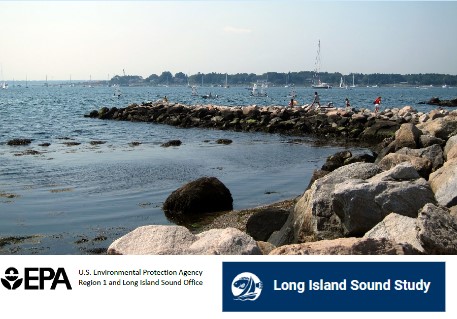What is the Nitrogen Reduction Strategy?
*New* An online interactive dashboard to view the technical information is now available (as of Oct. 30, 2023). See the sidebar with the light blue background for more information and a link.
EPA is implementing a strategy to aggressively continue progress on nitrogen reductions, in parallel with the States’ continued implementation of the 2000 Total Maximum Daily Load (TMDL), and achieve water quality standards throughout Long Island Sound and its embayments and nearshore coastal waters. The strategy recognizes that more work must be done to reduce nitrogen levels, further improve dissolved oxygen (DO) conditions, and address other nutrient-related impacts in Long Island Sound. The nitrogen reduction strategy complements the 2000 TMDL in important ways. Foremost, while the 2000 TMDL is premised on achieving water quality standards for DO in the open waters of Long Island Sound, the EPA strategy expands the focus to include other nutrient-related adverse impacts to water quality, such as loss of eelgrass, that affect many of the Sound’s embayments and nearshore coastal waters.
Ongoing Technical Coordination and Collaboration
EPA is working closely to share technical information, data, and approaches with other groups working on developing nitrogen reduction goals and strategies in the Long Island Sound watershed. Some examples include:

In 2018-2019 EPA conducted a public comment period and an independent technical review for two key deliverables of the Long Island Sound Nitrogen Reduction Strategy. The two products reviewed were: Subtask F/G: Summary of Establishing Nitrogen Endpoints for Three Long Island Sound Watershed Groupings, and Subtask E: Summary of the Hydrodynamic Analysis Conducted to Relate Tributary Loads to Areas of Influence and Relative Contributions to Embayments. Read a description of the purpose and scope of the External Review here. Find the External Review document here. See below for the revised subtask memos and detailed response to comments in the project deliverables list. Earlier deliverables were revised to make terms consistent throughout the subtask memo and to update the water quality data summary.
Documents
The following documents will help you learn more about the strategy:
EPA Nitrogen Strategy Subtask Memos and Supporting Documents (Updated 12/20/2022):
Project Map: a Study Area map of all watersheds evaluated in this memo.
- Literature Review Memo: Summary of available information concerning potential assessment endpoints and work conducted
- Subtask A: Data summary of individual nitrogen loads for 23 embayments, the Eastern Narrows, the Western Narrows, and Western LIS (Eastern Narrows and Western Narrows combined)
- Subtask B: Data summary of regulated point source discharges to LIS
- Subtask C: Data summary of tributary loadings to LIS, specifically the Connecticut, Housatonic, and Thames rivers
- Subtask D: Summary of existing water quality data collected and analyzed for 23 embayments; the Eastern Narrows; the Western Narrows; the Connecticut, Housatonic, and Thames rivers; and other water quality monitoring stations used for the analysis (includes additional embayments and open water)
- Subtask E: Summary of the hydrodynamic analysis conducted to relate tributary loads to areas of influence and relative contributions to embayments. Also, Response to Independent Technical Review of Subtask E
- Subtasks F/G: Summary of establishing nitrogen endpoints for three Long Island Sound watershed groupings. Also, Response to Independent Technical Review and Public Comments of Subtasks F/G
- Subtask H: Translation of nitrogen target concentrations, as documented in the subtasks F and G memos, into percent reduction target for watershed loads to each embayment waterbody within Long Island Sound
- Public Expert and External Technical Review Summary: Summary report of an independent technical review for Subtask E and Subtasks F/G
- Frequently Asked Questions on Long Island Sound Watershed Permitting (Under Revision)
- Quality Assurance Project Plan for technical approach (methodology),1/11/17
- Performance Work Statement for Phase 1 contract
- Performance Work Statement for Phase 2 contract
Resources
- Slide presentation from 11/29/18 public webinar
- 2017 Connecticut River Data Report
- Response to 11/8/17 public webinar questions
- Slide presentation from 11/8/17 public webinar
- Slide presentation from 12/19/16 public webinar
- Letter to State Commissioners on Proposed EPA Nitrogen Reduction Strategy
- Nitrogen Reduction Strategy
- Slide presentation from Public Meeting on Nitrogen Strategy, 4/15/16
Ongoing Public Outreach
- Letter to each of the states in the Long Island Sound watershed with attached nitrogen strategy on December 23, 2015.
- Public webinars on Feb 26, 2016, Dec 19, 2016, Nov 8, 2017.
- Formation in 2017 of a Technical Stakeholder Review Group, which includes all watershed states, NYC, Suffolk County, New England Water Pollution Control Commission and other groups collecting water quality data.
- Ongoing EPA-State meetings both in-person and conference calls on N strategy: New York State Department of Environmental Conservation, Connecticut Department of Energy and Environmental Protection, Massachusetts Department of Environmental Protection, Vermont Department of Environmental Conservation, New Hampshire Department of Environmental Services.
- Ongoing technical coordination meetings with Long Island Nitrogen Action Plan (LINAP), Suffolk Co, and CT Second Generation Nitrogen Strategy-Niantic River Project Team.
- Public meetings in 2016 held at the Stamford Government Center, Stamford, CT on April 13, the Huntington, NY Town Hall on April 15, and the Pioneer Valley Planning Commission in Springfield, MA on May 12 * Public presentations in 2016 at the May 3 Latitude 41 Conference and the September 21 Connecticut Environmental Health Association Conference.
- Meetings and calls at the request of the CT River Advisory Group (several WWTPs in MA and the Pioneer Valley Planning Commission), National Association of Clean Water Agencies, Connecticut Fund for the Environment, and others.
